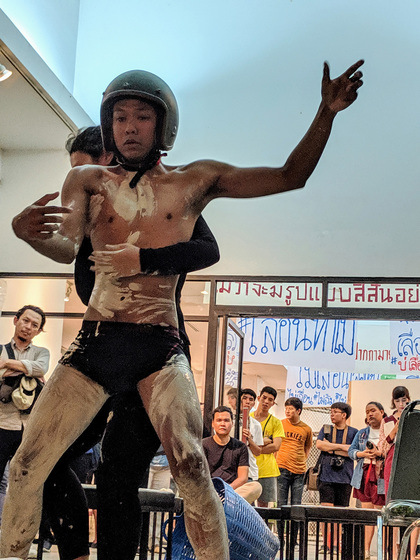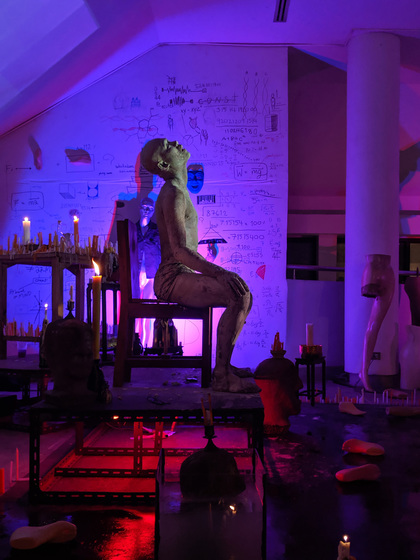
R
E
V N
E
X
T
Photo documentation of LANYIM THEATRE’s live performance Poiser, 13–16 August, 2019, at the exhibition ”Never Again: Seize, Trample, Repeat, Change,” Chiang Mai University Art Center, 2019. All images courtesy Lanyim Theatre.
The set for Lanyim Theatre’s four-day durational performance, Poiser (2019), was arranged across a large black square set on the concrete floor of the Chiang Mai University Art Center. The periphery of this square was lined with thin yellow votive candles, typically used to give merit at Buddhist temples. Echoes of the panel discussion hosted by exhibition organizers and Thai Lawyers for Human Rights reverberated against the corridor walls, creating an eerie aural setting for the mannequins, full bodied and limbless, scattered around the space. A simple wooden chair with a high back sat atop a black metal platform, and just behind it was a table crowded with candles oozing melted wax. A pregnant divine energy burdened this space, lit by the flickering projection on the back wall depicting a live feed of the entire scene.
Poiser was part of the exhibition “Never Again: Seize, Trample, Repeat, Change,” presenting the belongings of individuals who have resisted Thailand’s military government since the 2014 coup d’etat. Deciding to see the exhibition first, I rounded the corner and came across a white shirt, splattered with a protestor’s dried blood, hung in a plastic dry-cleaning bag in the corner.
Within the exhibition, political posters and stickers document an array of protests. Other objects are evidence of injustice. A train ticket to Ratchapakdi Park reveals the time and date authorities seized a train car filled with protestors on their way to an anti-corruption rally. On another table, a bunch of fresh chilies, salt, and garlic stand in for the spices confiscated from two students accused of unlawful public assembly in early 2019. In a gallery setting, these everyday objects acquire a special quality, becoming indexes of political inequity—and resistance.
Poiser also used everyday objects, but animated them through the performers’ interactions. When I returned to the foyer, the tidy rows of chairs were scattered, a tarp littered with mannequin appendages laid out on the floor. Initially, “poiser” appears to be a linguistic slippage, perhaps referring to someone who poses—an apt description for those lifted up to power who prove unworthy of it. Etymologically, it means one who poises or balances something, calling to mind the scales of justice, and Lanyim founder Nontawat “Golf” Machai’s fight for freedom after he was arrested in 2017 for holding a protest banner.
My friend whispered, “You missed it; he got his head shaved.” Thus, I arrived to Poiser late, catching Golf, clad in a black motorcycle helmet, tight fitting shorts, and a sports bra, handling the top half of a limbless mannequin with reverence. He placed it on the ground with great tenderness as Prapassorn Konmuang (Eye), dressed in black, approached from the other end of the corridor. Setting down her wooden staff, she turned to face her helmeted counterpart and slapped him. He slapped her back. She dug into a bucket of clay and wiped it across his body, tearing the sports bra off in order to cover every inch of his skin and his shorts in a cream-colored layer. He became still as a statue as she sculpted, and propelled him into the rarified realm of art. Breaking the spell after a few moments, a trickle of urine spilled down his legs and he grasped the staff, holding it parallel to the ground as he made his way down the corridor and defiled a photograph with his wet hand. Defiant, Golf now appeared untouchable.
The push and pull between the two performers landed them back within the black square. Golf set himself on the elevated wooden chair, the highest point of the dark laboratory. Eye prostrated before him, then continued covering him in clay, obliterating any glimpse of human flesh. A third performer, Laksanaree Duangtadam (Pim), scrawled formulas on the wall, an esoteric and meaningless gesture in context, emphasizing that what is considered sacred is often constructed.
Settings uphold power dynamics. Poiser exposed this opaque process, presenting throughout its duration a closed loop in which people were alternately subjugated and elevated. The performance provided no escape, simply insight into this process. It symbolized historical forgetting as power struggles play out, with each successive regime little better—or worse, even—than the last. When we bear witness to such an absurd cycle of repression subsumed under the aegis of “popular reform,” we must consider our own reality, and the role we can play to effect radical change.
The author wishes to thank Piyarat Duangmala for her assistance with additional research and translation.
To read more of ArtAsiaPacific’s articles, visit our Digital Library.
















